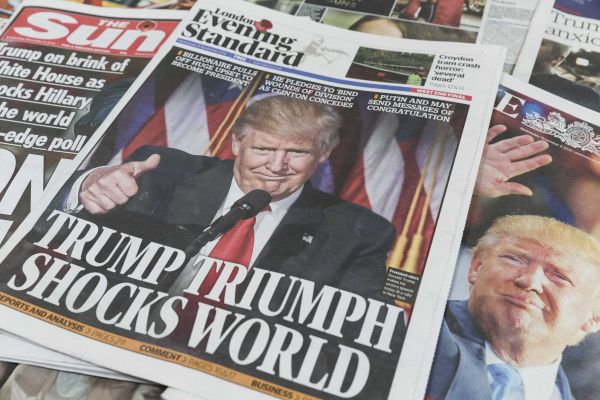
While 140 characters may have been more appealing than 700-word pieces, brevity is no longer enough
COMMENT | BAJINDER PAL SINGH | Social media are no longer the new kid on the block, but in 2016, platforms like Twitter and Facebook looked poised to nudge traditional newspapers into obsolescence. Following President Donald Trump’s victory in the United States, it seemed that the mainstream media had not only lost the plot, but had also lost their relevance.
Trump led the multi-pronged attack on traditional news media, and newspapers in particular. But many members of the press were also quick to declare that their own character limit had been reached. Accused of being elitist and out of sync with readers, newspapers’ reactions ranged from self-flagellation to repentance for the election result. Flummoxed by the clobbering from all sides, pundits who could not get the Trump election right prophesied that declining sales, falling readership, and flagging credibility heralded the demise of the newspaper, as we have known it.
But more than one year later, it is clear that Trump’s victory did not mean any such thing. On the contrary, his ascendancy has made the newspaper business more relevant than ever. The most remarkable media story of 2017 may have been how Trump inadvertently made newspapers great again.
Newspapers achieved this remarkable turnaround by doing what they do best: investigative journalism and breaking stories. Since November 2016, and particularly since Trump’s inauguration in January last year, newspapers have led with stories ranging from conflicts of interest involving Trump’s son-in-law, Jared Kushner, to evidence that the president’s former national security adviser, Michael Flynn, met with former Russian Ambassador Sergey Kislyak.
These tales of political intrigue competed for attention with lurid allegations of sexual misconduct by Hollywood producer Harvey Weinstein, U.S. Senate candidate Roy Moore, and other powerful men. And the pummelling of Trump with inconvenient facts has not been limited to Russia’s meddling in the election.
It is important to remember that newspapers’ investments in rapid-response investigative teams, long-form stories, and data-driven journalism are possible only because more people are paying for their news, especially through digital subscriptions. Millennials in the West, dismayed by the surge in “fake news,” are helping reverse declining circulations in major markets. Growth trends are even more pronounced in the Asia Pacific region, where readers in China and India are leading a return to traditional newspapers.
Of course, newspapers’ post-election rebound was not entirely their own doing; it was also facilitated by social media’s failure to consolidate its gains. Blinkered by the illusion of having snatched whatever influence newspapers commanded, social media’s mavens bungled their attempts to dethrone the older medium. Instead of breaking stories, they took to drafting manifestos, like Facebook founder Mark Zuckerberg’s 5,700-word jeremiad about nothing in particular. And, while there was a time when 140 characters may have been more appealing than 700-word opinion pieces, brevity is no longer enough. (Nor, for that matter, is lengthy incoherence).
Having abducted the truth, social media were at a loss about what to do with it. They did not innovate by, for example, following the lead of BuzzFeed, a once-notorious “clickbait” factory that soon expanded into serious reportage and long-form journalism.
After the U.S. election, BuzzFeed shook up the media industry by publishing the Steele dossier, a collection of private intelligence on Trump gathered by a former British MI6 officer. A few months later, it produced an 8,500-word expose on Milo Yiannopoulos, a former star commentator for Breitbart News. The Columbia Journalism Review called the article “groundbreaking,” though recent squabbles with CNN indicate a certain reluctance to accept BuzzFeed as a legitimate news organisation – and, potentially, even the emergence of a new media war.
Meanwhile, most major social media platforms continued to feature whatever presidential nonsense interested or amused their users, like analyzing “covfefe.” This has led many to assume that Trump himself drives the social media agenda. Perhaps he does. But Trump’s ad nauseam tweets about failing newspapers and fake news have also spurred more reasonable consumers to embrace newspapers as a bastion of anti-Trumpism. In other words, newspapers’ revival is a visceral, if partisan, response to social media in the Trump era.
Trump, the upstart, is leading the battle against the media Brahmins, buoyed by a fellow disruptor, social media. But Trump’s campaign is a losing one. Newspapers have gained allies even on Capitol Hill. When Congress grills executives from Facebook, Twitter, and Google, glee is evident in news headlines.
To add insult to social media’s injury, it is newspaper articles that are being relentlessly quoted in congressional testimony. For example, former FBI Director James Comey’s memo on his interactions with Trump, which led to the hiring of a special prosecutor to investigate the Trump campaign’s connections to Russia, was leaked to The New York Times.
As calls to rein in social media grow, it is the world’s newspapers – until very recently thought to be on the ropes – that have provided the reporting needed to convince policymakers to act. Because social media companies, for all their power and potential, never developed the journalistic capacities needed to displace traditional news media, the pendulum has changed direction.
*****
Bajinder Pal Singh is Director of Media and Communications at the Asian Institute of Technology in Thailand.
Copyright: Project Syndicate, 2018.
 The Independent Uganda: You get the Truth we Pay the Price
The Independent Uganda: You get the Truth we Pay the Price




Asian Age brings you the World & Bangladesh news, analysis, opinion, edit and videos on entertainment, latest lifestyle, culture & new technologies emerging worldwide.